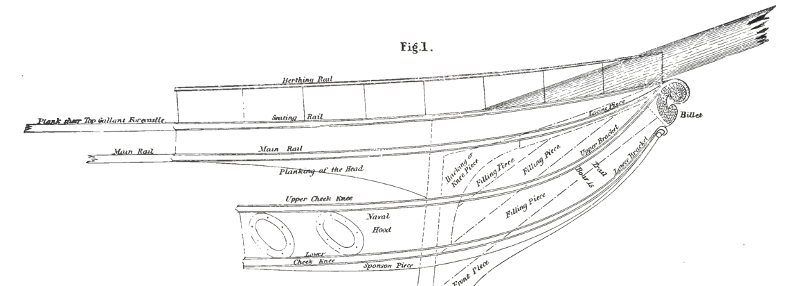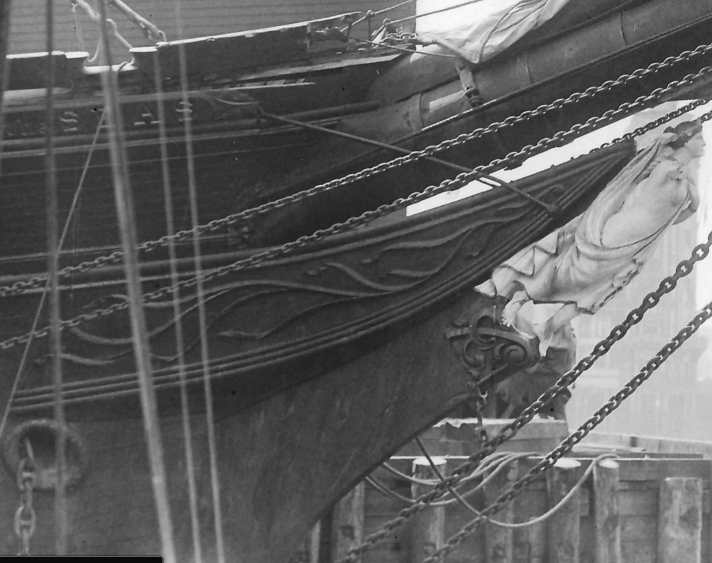
sob
Members-
Posts
93 -
Joined
-
Last visited
Content Type
Profiles
Forums
Gallery
Events
Everything posted by sob
-
some more research - Duncan McLean wrote articles about 161 (or so) ships launched between 1850 and 1856. I searched most (but not all) of these articles for "hood". I found mention of navel hoods in only 8 of the articles - only one McKay ship - the Flying Cloud here are the quotes from those mentions Flying cloud 1851 – McKay She has neither head nor trail boards, but forming the extreme, where the line of the planksheer and the carved work on the navel hoods terminate, she has the full figure of an angel on the wing, Samuel Lawrence – 1851 - Curtis She has a light billet head, ornamented with gilded carved work, and her trail-boards in their sweep take in the navel hoods and make a handsome finish forward. The line moulding of her planksheer is carried forward to the extreme, and rise with the bow in a bold and regular sweep, and harmonizes well with her sheer. Polar Star – 1852 - Foster She has a carved and gilded billet-head, and her trail boards and navel hoods are also covered with ornamental carving. The mouldings of her planksheer and main rail are continued to the forward extreme, and terminate in a point in the rear of the head, and their outline form the head-boards. Beverly – 1852 – Curtis She has a carved and gilded head, with ornamental work along the trail-boards and around the navel-hood J. Montgomery – 1852 - Badger The sweep of the trail boards takes in the navel-hoods, and makes a very neat finish forward. Orient – 1852 – Raynes She is planked up flush to the planksheer, has rounded or convex lines, and a carved and gilded billet head, with ornamental carving upon the trail boards and navel hoods. The moulding of the planksheer is carried forward to the billet, and forms the lower outline of her head boards Ocean Pearl – 1853 – Magoun It is a neatly carved and gilded billet, and its lower outline is the continuation of the moulding of the planksheer; and the trailboards and navel hoods are blended in one, and are ornamented with carved work. Webster – 1853 – Raynes She has a carved and gilded billet head, and carved work upon her trail boards and navel hoods, and the lower outline of the head boards is the continuation of the moulding of her planksheer, and its upper outline is the moulding of the outside clamp between the rack and the main rails All of these quotes, from the time of the Flying Cloud, are consistent with the definition of navel hoods that I included in my last post that's all for now Scott
-
seems to me that the definition of navel (or naval) hoods was basically the same from the 1700s to the 1950s and that was beams around the hawse holes to support them or to guide the anchor rope into them I have found no indication that the term navel hood was applied to the kind of beak that the Glory had above the figurehead so I think we will just agree to disagree on what the beaks were known as if those beaks were only on McKay ships they sure could have been an important development it does appear that I need to work some on my Flying Cloud drawings to better conform to what McLean describes Scott
-
yes, Duncan McLean's article mentions that the Flying Cloud had "navel hoods" that have carved work on them but it says "where the line of the planksheer and the carved work on the navel hoods terminate, she has the full figure of an angel on the wing" i.e., the figurehead starts where the navel hoods end which does indicate some sort of framing that carried up the back of the figurehead Scott
-
Thanks, now I understand what you are referring to on the Glory - harder to see on the two photos you posted none of the contemporary paintings of the Flying Cloud are clear enough to see if she had a substantial hood as the Glory did but, if the McKay hull drawing is to be accepted ether was not room for a substantial hood - maybe enough room for a thin one with the planksheer brought forward over the figurehead (as is shown in the first photo)
-
if that is the case, what exactly is the hold that McKay used - i.e. what does it look like - the only think iI see in the two pictures you show is maybe an enlarged bow below the figurehead? the drawing of the bow of the Flying Cloud in Hall's report (which he may have gotten form Mary McKay) is this: and the McKay drawing itself is this: I'm trying to figure out what you are referring to are you referring to A or B or something else? thanks
-
Hi, this is Scott Bradner. A friend pointed me at this blog when he noticed that there had been some discussion about my plans for the Flying Cloud that I posted. https://www.sobco.com/ship_model/fc/Flying_Cloud_plans_bradner.html In particular, he pointed me to a discussion about naval hoods from about a year ago. The question being ‘Did the Flying Cloud have naval hoods?’ Until I read the discussion, I had never heard of naval hoods and I could not figure out from the discussion just what they were, so I did some research. I found mention of naval hoods in a number of documents published in the late 1800s. They generally indicated that naval hoods had something to do with the hawse pipes. For example: “Navel Hoods. Those hoods wrought above and below the hawseholes, outside a ship, where there are no checks to support a bolster.” (Sailor's Word-Book: An Alphabetical Digest Nautical Terms, 1867) The best reference I found was in “An Outline of Ship Building” by T D Wilson, published in 1880. (Available from the Internet Archive.) This document mentions naval hoods in a number of places, most detailed on page 243 it also has a useful drawing on page 422 . The description on page 243 of this book is: “The naval-hoods are the filling pieces placed between the cheek-knees extending to the rabbet of the stem, on which the outer flanges of the hawse-pipes rest. The trail-boards abut against the naval-hoods and run up to the billet; they are carved or plain, to correspond with the finish of the billet. They are mitred where they abut the naval-hoods, and are secured with screws, so that they can be removed to caulk the hood ends” And here is the drawing: The text and the drawing (along with all of the other descriptions I found) make it clear that the naval hoods are constrained to be right around the hawse pipe(s). If the ship has trail boards, they extend from the naval hoods up to the billet or figurehead. Note that Duncan McLean’s detailed article about the launching of the Flying Cloud specifically said that the ship did not have trail-boards. The photo that was used in the discussion on this list was of the bow of the Glory of the Seas: Based on the definitions I found in the 1880’s documents and the description and drawing in Wilison, I do not see naval hoods in the Glory photo. It seems to me that naval hoods on a ship that does not have trail-boards, such as the Flying Cloud, would be short beams below, above or both, the hawse pipe(s). The Glory photo does not show any such beams. It does show the bottom edge of the trail-board close to the top of the hawse pipe but it does not look like it could be used to support the hawse pipe in any way. In my searching have not found any evidence that the Flying Cloud did have naval hoods. But even if she did, they would likely not be visible, just like the photo of the Glory shows. Well, that is what I understood from the references I found. Please let me know if I’ve misunderstood what naval hoods were.
About us
Modelshipworld - Advancing Ship Modeling through Research
SSL Secured
Your security is important for us so this Website is SSL-Secured
NRG Mailing Address
Nautical Research Guild
237 South Lincoln Street
Westmont IL, 60559-1917
Model Ship World ® and the MSW logo are Registered Trademarks, and belong to the Nautical Research Guild (United States Patent and Trademark Office: No. 6,929,264 & No. 6,929,274, registered Dec. 20, 2022)
Helpful Links
About the NRG
If you enjoy building ship models that are historically accurate as well as beautiful, then The Nautical Research Guild (NRG) is just right for you.
The Guild is a non-profit educational organization whose mission is to “Advance Ship Modeling Through Research”. We provide support to our members in their efforts to raise the quality of their model ships.
The Nautical Research Guild has published our world-renowned quarterly magazine, The Nautical Research Journal, since 1955. The pages of the Journal are full of articles by accomplished ship modelers who show you how they create those exquisite details on their models, and by maritime historians who show you the correct details to build. The Journal is available in both print and digital editions. Go to the NRG web site (www.thenrg.org) to download a complimentary digital copy of the Journal. The NRG also publishes plan sets, books and compilations of back issues of the Journal and the former Ships in Scale and Model Ship Builder magazines.










